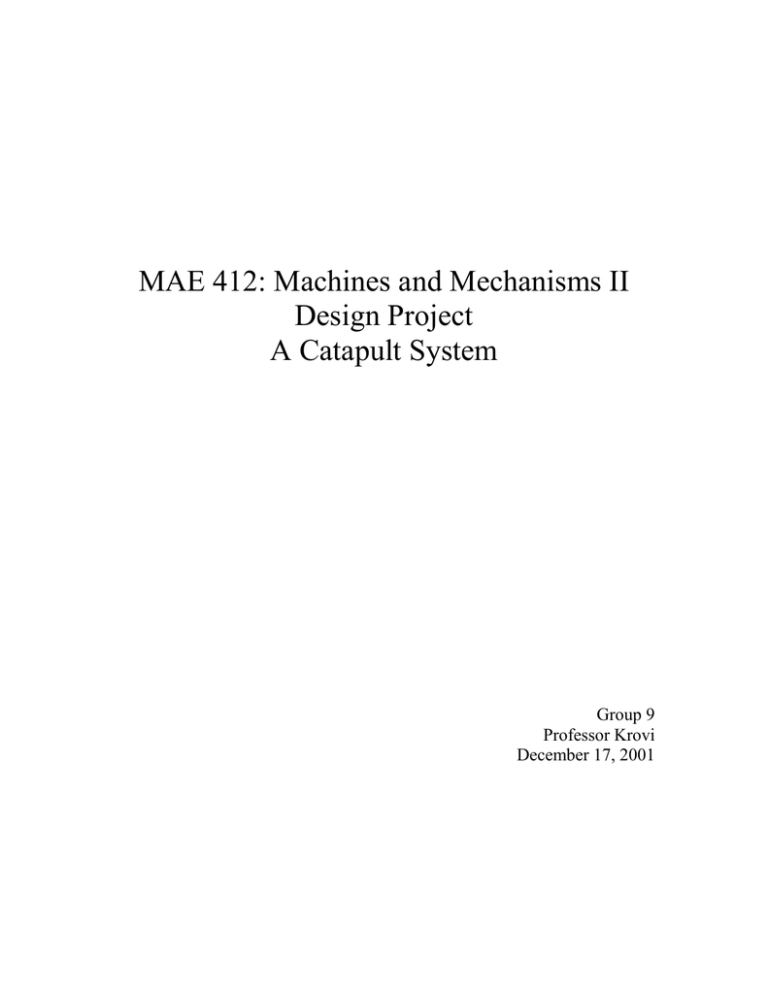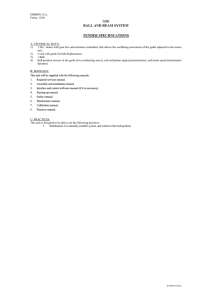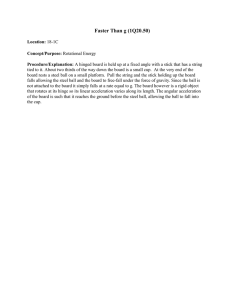MAE 412: Machines and Mechanisms II Design Project
advertisement

MAE 412: Machines and Mechanisms II Design Project A Catapult System Group 9 Professor Krovi December 17, 2001 Table Of Contents Introduction q Idea generation q Physical construction Description of Mechanisms q Hand Drawing q Auto Cad q Adams Simulation Design Analysis Discussion Introduction: As group #9 met to discuss the MAE412 project, there was much enthusiasm. The group project was to design and build a ball-launcher, which utilized a 4-bar mechanism in any means to perform the task. There were many constraints imposed upon the assignment, which forced all the groups to become increasingly clever with their designs. Since there was some mechanism in place to constructively debate the rules, there were several concessions made half way through the project, which undoubtedly helped most groups while hindering others. The resulting constraints (common to all groups) were ultimately limited to: mechanism type (minimum 4-bar mechanics), motor, energy source (no potential or stored up energy), projectile type (regulation squash ball), mechanism dimensions (2’ x 2’ x infinity) and time limit which was set at (20) seconds per launch from power on to ball release. Judging the best mechanism included the sum of the distances of three independent launches, compliance with the project constraints, compactness, esthetics and over all creativity. Our design utilized a wooden base and motor mount stanchion as the ground, an adjustable drive fork as the input link (actuated by the motor), and a variable pitch leaf spring as the output link. The main element, which made our controversial ball launcher a true 4-bar mechanism, was the bearing we used as a coupler link. Since the bearing (fitted to the end of the input link) is considered a “higher order pair” type link the true length of our coupler (only .093 inch radius) completes the design requirements “by the book”. There were many design iterations, which led to our final design, which are noteworthy. Initial group discussions were not productive because there were too many ideas and not enough scrutinizing of how they fit into our design criteria. Subsequent meetings were more productive because each member was given the opportunity to freely state reasons why they were for or against the various design proposals. As our group meetings progressed our ideas began to gel into a common goal. By the fourth meeting the group was in agreement that it was clearly time to build. Like most plans, the design began to change as the build process progressed. The special AISI 1095 spring steel that was purchased for use as our output link (which we attached to our end effecter) was found to require additional heat-treating to achieve our desired mechanical properties. The group was able to substitute a length of “feeler gage” stock from a local industrial supply source because it was found to have similar properties to the AISI 1095 steel and excellent “memory”. Our tiny ball bearings (purchased from Buffalo Bearing Inc.) were not used because it was determined that locational precision the likes of which were unobtainable from our archaic power tools was required for proper assembly and operation. Once again we compromised our design by substituting the ball bearings for a revolutionary unibearing design made from a length of the finest brake line money can buy. Our low tech. higher order pair required low assembly precision between the input link and the output link. Although this substitution resulted in taking a giant step backwards in our attempt to reduce frictional forces, the end result got the job done nicely. Our end effecter was upgraded from a milk jug cap to a three dimensional quadra-leg fixture made from steel drywall corner flashing and resembling a piece of modern art. The great idea of making a variable pitch follower link proved extremely useful during our optimization trial runs. Once again, teamwork and unselfish compromise yielded successful results. In the end, our final mechanism (named “BABY”) became one of the 2/3 of all project mechanisms that actually worked. Our event performance summary was three successful competition launches at distances of 102”, 102” and 90” respectively. Our combined distance of 294” was comparatively respectable among the other groups. As it turned out our greatest constraint proved to be the strength of the plastic gears within the sanctioned motor itself. It appears as if the company that manufactures the miniature worm gear motor either designed the electric motor too powerful for the gears or the gears were not engineered to be strong enough to transmit the power adequately. Our group experimentally verified these theories by systematically stripping four gear trains. We found that our gears striped out prematurely at torque levels far below that of our motor’s capacity. Perhaps the importance of learning to work together and accomplish a task as a group was the greatest side lesson of this project. I know that I speak for all of group #9 when I say that the machines and mechanisms group project of the fall semester, 2001 will always serve as a reminder of the importance of proficiency in group design synthesis and a memorable part of our UB engineering experience. Description of Mechanisms: Included with this report we have added a few drawings that represent and show our model as various different views. q A hand drawn 3-D view of our catapult. q 2 auto cad drawings that show 2 views (side views and front view). q Adams is included also, with acceleration and velocity graphs and profiles. Force Analysis: FBD 1 Assumptions 1) No Friction within system 2) No air resistance 3) Static Loading at the moment before release Known: Ball Mass – 24 grams Steel Mass – 25 grams Ksteel = 68.9 N/m Torque (T) = 7.5 oz.-in. Delta x – about .1016 meters Conversion factors: 1 oz = .02835 kg 1 in = .0254 meters Sum of Forces in x direction ΣFx = 0 -X=0 a = 9.8 m/s^2 F = Tra = 7.5*.02835*.0254*3.5/.0254*9.8 = 7.29 N Sum Forces in y direction Σ Fy = 0 Y = F + Ms a + Mb a – kx =7.29+25*9.8+24*9.8-68.9*.1016 y = 473 N Sum of Moment Σ Ma=0 =24*9.8*2*.0254+25*9.8*4*.0254-473*10 = -M M = 4693 N-m Distance Known: Ax = 0 Ay = 0 T = 1.5 sec (from actual competition) (From experimental results) Voy = 1.63 m/s Vox = 1.63 m/s Vo = 2.3 m/s Velocity Table Time (sec) Trial 1 2 3 4 5 6 7 8 9 10 11 12 Distance (meters) 1.5 1.54 1.49 1.52 1.59 1.56 1.52 1.52 1.47 1.52 1.44 1.42 Velocity (xdirection) 2.56 2.38 2.4 2.73 2.28 2.27 2.35 2.3 2.51 2.35 2.65 2.83 Average Vx = Vy since it is at a 45 degree angle Distance: Theory X = Vox t 1.7 1.54 1.61 1.79 1.43 1.45 1.54 1.51 1.7 1.55 1.83 1.99 1.63 = 1.63*1.5 =2.45 meters Actual (competition) X = 2.59 meters %error = 5.4 % Analysis Section: The above calculations are approximate values of the velocity and acceleration of the system. Being that we designed a high level system we were unable to solve for some values in our system using only knowledge gained in this undergraduate course. We can by inspection calculate these values to the best of our ability. Theta 1 – 0 degrees Theta 2 – 45 degrees Theta 4 – 180 degrees Theta 3 – Unknown R1 – 15 inches R2 – 8 inches R3 – Unknown R4 – 3.5 inches Torque needed by motor – 7.5 oz-in which equals a 7.29 Newton force to drive the system Velocity Theta 1 = 0 Theta 2 = 2.3 m/s Theta 3 = Unknown Theta 4 = 10 rev/sec As I stated above, due to the complex nature of our design ordinary analysis is very difficult and above our scope of knowledge. Simulation Design: In order to come up with the dimensions that we used, we felt that this design should be the smallest as possible and not to heavy either. This should be a design that does not cost a lot of money, as well as being optimized at whatever size it is. We decided to use spring steel overlapping a ramp at about 6 inches, this is the height at which soon after the motor will get stuck and break gears. At a height of 6.5 inches it to much spring steel and problems happen. Our motor was placed on a mount that was 7 inches above the base with a rotating crank arm attached to it, when rotated around it will make contact bringing back the spring steel to a 45 degree angle and releasing it while the ball is shot at a projector of about 53 degrees. Which we found to be the optimal angle for the ball to be shot a maximum of 15 feet. Well as our design results show we did not make that estimation but a good 9 feet is not bad. The crank arm that we used was held together by two bearings which we friction resistant and were able to roll the spring steel along the crank arm springing forward with a great strength. This is where we hand our design parameter problems. Often our gears were breaking and grinding because of the spring steel being to far out. Which I stated earlier as our main optimization goal to overcome, the height of the spring steel and at what angle it should be release. Discussion of the Performance: The performance of our project was expected to do a little bit better; our main problem is the gears that we were using. We were given a motor with plastic gears which we broke many of them trying to maximize the force of the motor. When the gears were breaking, it took a while for us to be able to set the correct amount of spring steel to be touched by our rotating crank. After that was found, we then realized what our problem was. There were to many spring steel pieces added together and there was not enough force in the spring when the crank brought it back to release the ball. What we could of done differently for this design, was to make sure that we new all specs of the motor before hand. However that would be accomplished, I think that it would of helped us out a little bit. Knowing the actual force and speed that the motor would have been able to output. By this knowledge we could of broke less gears and shot the ball further. Also we might want to try and design a different and simpler design, making sure that it would have been easy to analyze and complete the ADAMS.


